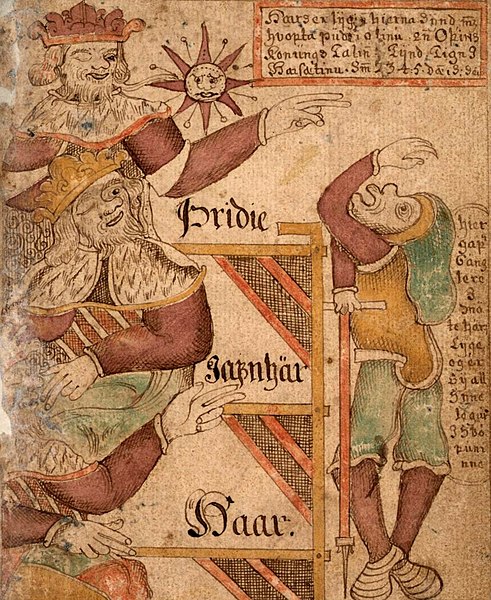Skáldskaparmál is the second part of the Prose Edda, compiled by Snorri Sturluson. It consists of a dialogue between Ægir, the divine personification of the sea, and Bragi, the god of poetry, in which both stories of the Æsir and discourse on the nature of poetry are intertwined. The work additionally includes tales of human heroes and kings. The overarching mythological setup gradually fades and the work becomes more of an early form of a poetic thesaurus of Old Norse, presumably intended for usage by skalds. Much of the work is focused on poetic phrases and descriptors. The origin of these kennings is given; Bragi delivers a systematic list of kennings for various Æsir, people, places, and things. He then goes on to discuss poetic language in some detail, in particular heiti, essentially poetic synonyms or alternate words. For example, the simple hestr, "horse", might be replaced by jór, "steed".

Near a wood, the goddess Sif rests her head on a stump while Loki lurks behind, blade in hand. Loki intends to cut Sif's hair per a myth recounted in Skáldskaparmál.
Illustration from Icelandic Manuscript, SÁM 66 of Thjazi in giant eagle form while Odin, Loki, and Hoenir attempt to cook in a cauldron below
Baugi using his auger to drill a hole in the mountainous Hnitbjörg (Illustration from SÁM 66)
Odin seducing Gunnlöd (Lorenz Frølich)
The Prose Edda, also known as the Younger Edda, Snorri's Edda or, historically, simply as Edda, is an Old Norse textbook written in Iceland during the early 13th century. The work is often considered to have been to some extent written, or at least compiled, by the Icelandic scholar, lawspeaker, and historian Snorri Sturluson c. 1220. It is considered the fullest and most detailed source for modern knowledge of Norse mythology, the body of myths of the North Germanic peoples, and draws from a wide variety of sources, including versions of poems that survive into today in a collection known as the Poetic Edda.
Title page of a late manuscript of the Prose Edda written by Snorri Sturluson (13th century), showing the Ancient Norse Gods Odin, Heimdallr, Sleipnir, and other figures from Norse mythology
Gylfi and High, Just-as-High, and Third. Manuscript SAM 66 (Iceland, 1765–1766), Reykjavík, Árni Magnússon Institute for Icelandic Studies.
Thjazi and Loki. Beginning of the myth of the abduction of Iðunn, attested in Skáldskaparmál. Manuscript NKS 1867 4to (Iceland, 1760), Copenhagen, Royal Library







